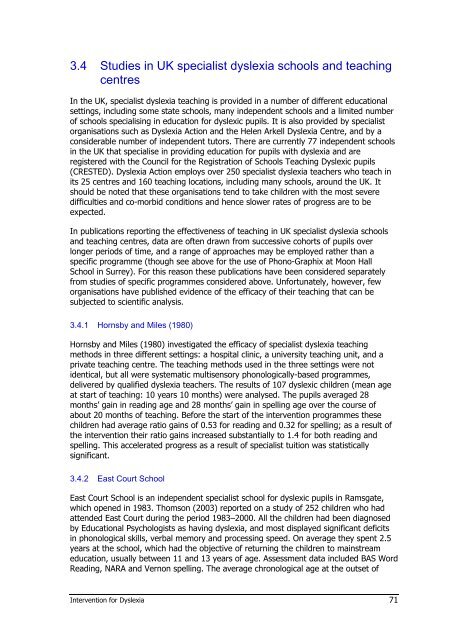Intervention for Dyslexia - The British Dyslexia Association
Intervention for Dyslexia - The British Dyslexia Association
Intervention for Dyslexia - The British Dyslexia Association
Create successful ePaper yourself
Turn your PDF publications into a flip-book with our unique Google optimized e-Paper software.
3.4 Studies in UK specialist dyslexia schools and teaching<br />
centres<br />
In the UK, specialist dyslexia teaching is provided in a number of different educational<br />
settings, including some state schools, many independent schools and a limited number<br />
of schools specialising in education <strong>for</strong> dyslexic pupils. It is also provided by specialist<br />
organisations such as <strong>Dyslexia</strong> Action and the Helen Arkell <strong>Dyslexia</strong> Centre, and by a<br />
considerable number of independent tutors. <strong>The</strong>re are currently 77 independent schools<br />
in the UK that specialise in providing education <strong>for</strong> pupils with dyslexia and are<br />
registered with the Council <strong>for</strong> the Registration of Schools Teaching Dyslexic pupils<br />
(CRESTED). <strong>Dyslexia</strong> Action employs over 250 specialist dyslexia teachers who teach in<br />
its 25 centres and 160 teaching locations, including many schools, around the UK. It<br />
should be noted that these organisations tend to take children with the most severe<br />
difficulties and co-morbid conditions and hence slower rates of progress are to be<br />
expected.<br />
In publications reporting the effectiveness of teaching in UK specialist dyslexia schools<br />
and teaching centres, data are often drawn from successive cohorts of pupils over<br />
longer periods of time, and a range of approaches may be employed rather than a<br />
specific programme (though see above <strong>for</strong> the use of Phono-Graphix at Moon Hall<br />
School in Surrey). For this reason these publications have been considered separately<br />
from studies of specific programmes considered above. Un<strong>for</strong>tunately, however, few<br />
organisations have published evidence of the efficacy of their teaching that can be<br />
subjected to scientific analysis.<br />
3.4.1 Hornsby and Miles (1980)<br />
Hornsby and Miles (1980) investigated the efficacy of specialist dyslexia teaching<br />
methods in three different settings: a hospital clinic, a university teaching unit, and a<br />
private teaching centre. <strong>The</strong> teaching methods used in the three settings were not<br />
identical, but all were systematic multisensory phonologically-based programmes,<br />
delivered by qualified dyslexia teachers. <strong>The</strong> results of 107 dyslexic children (mean age<br />
at start of teaching: 10 years 10 months) were analysed. <strong>The</strong> pupils averaged 28<br />
months’ gain in reading age and 28 months’ gain in spelling age over the course of<br />
about 20 months of teaching. Be<strong>for</strong>e the start of the intervention programmes these<br />
children had average ratio gains of 0.53 <strong>for</strong> reading and 0.32 <strong>for</strong> spelling; as a result of<br />
the intervention their ratio gains increased substantially to 1.4 <strong>for</strong> both reading and<br />
spelling. This accelerated progress as a result of specialist tuition was statistically<br />
significant.<br />
3.4.2 East Court School<br />
East Court School is an independent specialist school <strong>for</strong> dyslexic pupils in Ramsgate,<br />
which opened in 1983. Thomson (2003) reported on a study of 252 children who had<br />
attended East Court during the period 1983–2000. All the children had been diagnosed<br />
by Educational Psychologists as having dyslexia, and most displayed significant deficits<br />
in phonological skills, verbal memory and processing speed. On average they spent 2.5<br />
years at the school, which had the objective of returning the children to mainstream<br />
education, usually between 11 and 13 years of age. Assessment data included BAS Word<br />
Reading, NARA and Vernon spelling. <strong>The</strong> average chronological age at the outset of<br />
<strong>Intervention</strong> <strong>for</strong> <strong>Dyslexia</strong> 71









